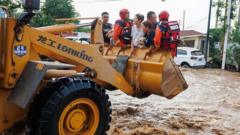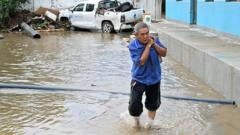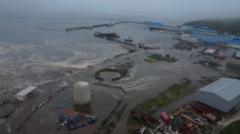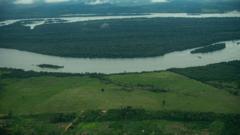Over 30 individuals have lost their lives in severe flooding across Beijing, which has necessitated the evacuation of over 80,000 residents. The deluge is part of a broader trend of extreme weather affecting China this summer, with President Xi Jinping urging all-out rescue efforts.
Catastrophic Flooding in Beijing Claims 30 Lives Amidst Extreme Weather Events

Catastrophic Flooding in Beijing Claims 30 Lives Amidst Extreme Weather Events
Historic rainfall leads to deadly floods in Beijing, prompting mass evacuations and urgent rescue operations as authorities respond to a summer of unprecedented weather.
At least 30 people have died in the recent floods that have inundated Beijing, forcing more than 80,000 residents to evacuate, according to officials. The torrential rains have wreaked havoc on streets, buildings, and essential infrastructure in northern China. In addition to the fatalities in Beijing, a landslide in Chengde city, approximately three hours northeast of the capital, led to eight more deaths on Monday.
This summer has seen China grappling with extreme weather conditions. Earlier this month, eastern regions faced unprecedented heatwaves alongside the southwest experiencing devastating floods. In light of the ongoing crisis, President Xi Jinping has called for "all-out" emergency response efforts, instructing authorities to prepare for potential worst-case scenarios.
"No effort should be spared to search for and rescue those missing or trapped, and to transfer and resettle residents from affected areas to minimize casualties," the president emphasized during a meeting on Monday. The Chinese government has mobilized 200 million yuan (around $28 million) for recovery initiatives, including the restoration of damaged roads and power supply.
Areas in the outskirts of Beijing, particularly the suburban districts of Miyun and Huairou, have been critically impacted by the floodwaters. Numerous roads have been rendered unusable, and power disruptions have affected more than 130 villages, compounding the challenges faced by residents and emergency services. Videos circulating online depict rescuers navigating through chest-deep water to assist stranded individuals, while drones and helicopters deliver food and supplies to those in need.
Reports have emerged of residents being cut off from communication and aid. Yang, a resident of Hebei province, expressed deep concern for her family living in the inundated Miyun district, sharing her anxiety over their lack of contact since Sunday. Her family struggles with health issues and has pets relying on them for care. Frantically, Yang turned to social media desperate for rescue, fearing that her family's remote village might go overlooked.
Witnesses of the flooding have described the swift and unsettling onset of the disaster. Zhuang Zhelin, a shopkeeper from Taishitun town, remarked on the shocking speed with which the area was overwhelmed. "The flood came rushing in, just like that," he recounted, recalling a panicked evacuation as waters rose swiftly.
Beijing historically experiences flooding, particularly during this season. One of the most catastrophic floods occurred in July 2012, when record rainfall led to 79 fatalities. This year alone, widespread flooding has brought calamity to several regions across China. Earlier in the summer, Typhoon Wipha claimed two lives and left ten people missing in Shandong province, while a landslide in Ya'an city resulted in three fatalities.
Experts assert that such extreme weather patterns are increasingly related to climate change, which continues to jeopardize the safety and economic stability of the nation, especially within its multifaceted agricultural sector. Reports indicate that natural disasters have caused economic damages totaling 54.11 billion yuan ($7.5 billion) in the first half of the year, with flooding alone accounting for over 90% of these losses, as confirmed by China’s emergency management ministry.



















